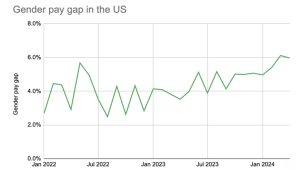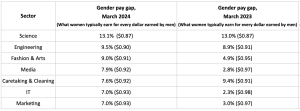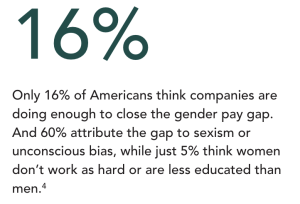The great thing (in theory) about HR, is that it’s a profession that has progression baked in as one of its key, and founding pillars.
It’s where those that represent employees pledge to ensure that the workplaces staff inhabit today are always better, more equal, fairer, and less prejudicial than they were of yesteryear.
And, generally speaking, this mantra has held true.
Modern workplaces are completely different to the 1980s or 90s, when people could light up at work, be casually racist and misogynous and be a bully to co-workers.
And yet here we are in 2024, with one embarrassing problem – the fact that when it comes to gender pay gaps, things don’t seem to be progressing at all, but are actually going backwards.
The gender pay gap has doubled


Last week startling new figures from job engine firm, Adzuna (above), revealed that the gender pay gap in the US had actually doubled in the last two years – rising from 2.9% in April 2022 to 6.0% in April 2024.
A pay gap of 6% means that a female earns 94 cents for every one dollar earned by a man doing the same job.
But this average means there are sectors where the gap is even larger.
Women in IT earned 7% less than their male colleagues in March 2024, up five percentage points compared to the previous year of 2.3%
Worse than this though, the data finds that women in STEM fields – such as science and engineering – face even larger disparities in pay.
In March 2024, women in science earned 87 cents for every dollar earned by a man, while women in engineering earned 90 cents for every dollar earned by men.
Overall, in March 2024, the gender pay gap in science was a massive 13.1% (up from 7.7% in 2022), while in engineering the gap is 9.5%.
This means that females in science and engineering typically earned 87 cents and 90 cents respectively, for every dollar earned by males.
In the legal sector, the research reveals gender pay gaps increased by 11 percentage points, while in marketing men still earn 7% more than women.
‘Ingrained gender biases’
Of all the sectors looked at, Adzuna found accounting was the only one to record women earning ‘more’ than men [women in accounting earned $1.04 for every dollar earned by men].
It suggests an ongoing culture of what it calls “ingrained gender biases and structural barriers that perpetuate occupational segregation.”
Talking to TLNT Adzuna’s head of data science, James Neave said: “The gender pay gap in the US has now reached its highest level since coming out of the pandemic.”
He added: “Despite ongoing endeavors to enhance female participation and representation, the scales remain overwhelmingly tilted in favor of men, with women in science still earning a staggering 13% less than their male counterparts on average. Our data underscores a pressing need for better efforts to advance gender parity in the workplace.”
What’s to blame?

Source: https://nationalpartnership.org/report/wage-gap/
Last year Pew Research revealed pay gaps between men and women had barely changed since 2002.
It found there was “no single explanation for why progress toward narrowing the pay gap has all but stalled in the 21st century,” but it added that because women begin their careers with a pay disparity, this follows them (and widens) at every subsequent stage of their career.
In fact, it found that as women age, the gender pay gap increases. It found women aged 25-34 in 2010 already earned 92% as much as men their age. But by 2022, this same group of women, now aged 37-46, earned only 84% as much as men of the same age.
While parenthood is also a factor [the pay gap is greatest for women that have children at home], Pew suggests some family-friendly policies in the US may actually be contributing to the pay gap from closing – because in increases proximity bias.
As such it urges CHROs to think more in the round about how their policies pan out in practice, because overall women employed in the United States lose a combined total of more than $1.6 trillion every year due to the wage gap.
More has to change

Source: LeanIn
Even though the US has banned unequal pay for equal work since 1963, it’s clear from these latest Adzuna figures that more needs to be done by CHROs to address this challenge.
From 1967 to 2021, women experienced a cumulative loss of $61 trillion in wages due to the gender wage gap – an amount that was nearly double the US government debt in 2023.
Campaign group, American Progress, says more effort is needed “to better attract and retain women in high-paid occupations, in which women are underrepresented,” and once women are in these jobs, better career pathways are also needed, so that ongoing progression does not stall.
Recent salary transparency laws should force employers to hire equally at the point at which men and women start their careers.
But so far only around 30 states have taken steps to raise their minimum wages to above the federal minimum wage level.
In some US states, employers are now barred from asking job applicants how much they previously earned – a factor that many say perpetuates pay divides, because employers will get away with only having to pay a new joiner a fraction more than what they are already on.
California, Massachusetts, New York City and Puerto Rico are among the jurisdictions that ban employers asking about previous salaries. Similar measures are now under consideration in more than 20 other states – but this may still take some time to happen.
According to Professor Allison Elias, author of “The Rise of Corporate Feminism,” pay gaps cannot be attributed to “women’s choices alone” and says that at-work dynamics do not always help.
In a recent interview she said: “We also know from experimental research in social psychology that women receive less credit —and also claim less credit —for their work when engaged in joint tasks with men.”
She adds: “I co-authored a recent paper with Jirs Meuris [Assistant Professor in the Management and Human Resources Department at the University of Wisconsin-Madison], where we examine almost two decades of data to demonstrate the effect on the gender wage gap of a job’s interdependence, meaning the extent to which a job requires working on a team or coordinating with others. Over time and across industries and occupations, jobs that are rated as more interdependent, meaning they require two or more people to sequentially complete tasks, have higher gender wage gaps.”
Elias suggests CHROs should not blame pay gaps on wider societal issues alone, and says they have a responsibility to address their performance evaluation systems as a minimum first step.
Other steps CHROs could take include running pay audits (analyzing compensation by gender), ensuring hiring and promotions are made more fairly (including training managers on gender bias), and putting clear and consistent criteria in place to reduce bias in staffing decisions and performance reviews.
Managers need to establish a list of defined priorities around closing the gender pay gap, and these priorities should then be converted into quantitative goals in a raise allocation process.
Be better
Ironically, Adzuna says that where progress has been made is in closing gender pay gaps in HR – so the data does at least prove that improvements can be made.
It also notes that in banking and finance the gender pay gap has also been reduced – it’s now down to 1.4% in March 2024 from 3% in March 2022.
This means women in banking and finance earned 99 cents for every dollar earned by men.
Clearly improvements can – and are – happening.
But more improvements ‘have’ to be made.
CHROs should really consider this: Do you really want to be here in another year’s time, reading how pay gaps have continued to worsen rather than improve?
HR is surely better than this – and should take these newest findings as a wake-up call to really do something substantial about it.
EQUAL PAY DAY
Every year in America, Equal Pay Day is marked rather than celebrated.
The date symbolizes how far into the year a women must work to earn what men earned in the previous year.
This year, Equal Pay Day was March 12.
For black and African women – who suffer some of the worst levels of unequal pay – their equal pay day doesn’t arrive until August 22.
